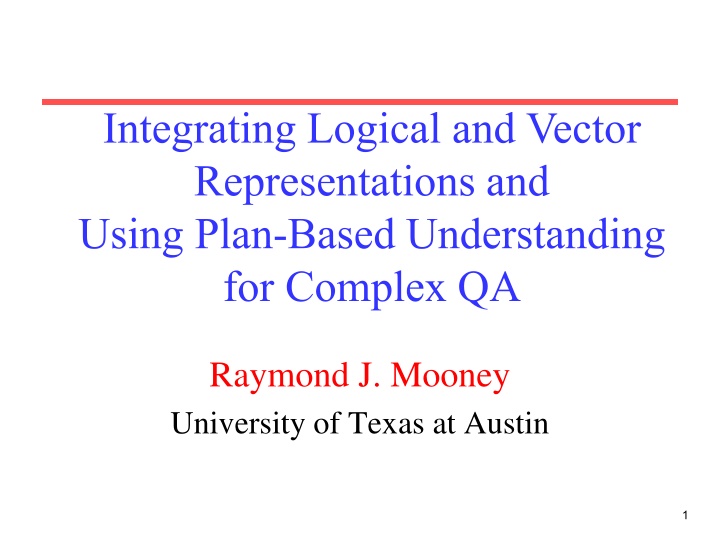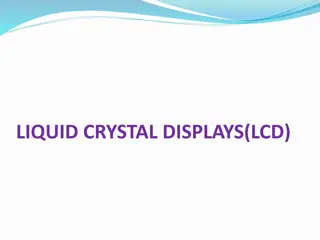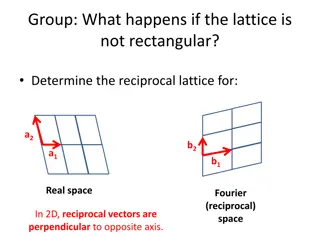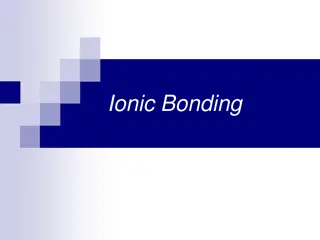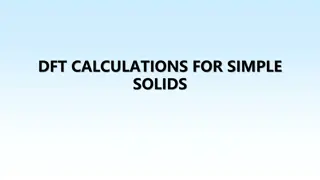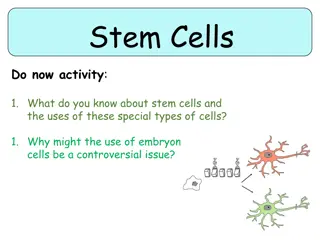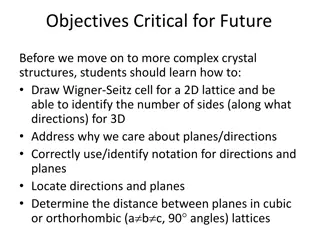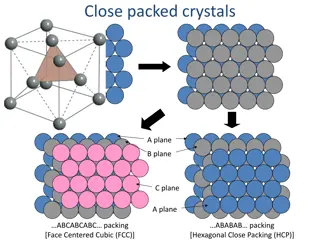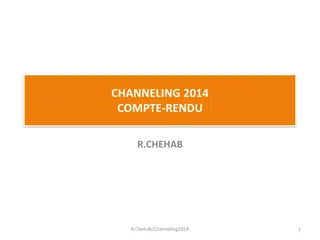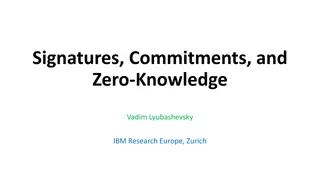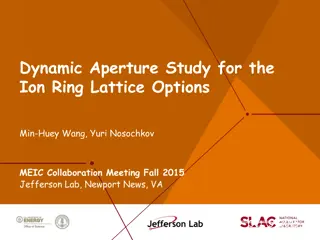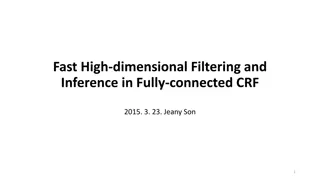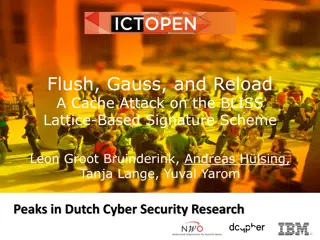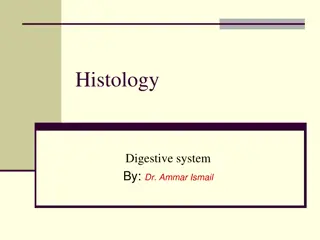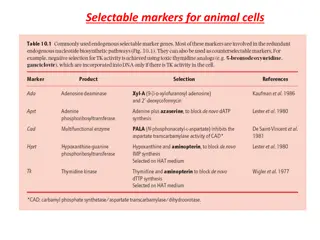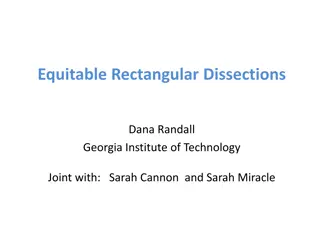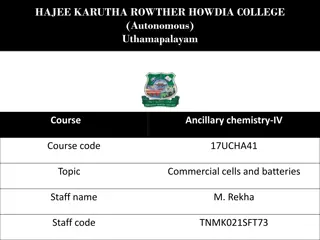Crystal Geometry and Lattice Cells
A primitive lattice cell, also known as a unit cell, is the minimum volume cell used to build a crystal. Explore crystal geometry, lattice parameters, and primitive cells in the context of crystallography. Learn about crystal lattice planes, Miller indices, and Wigner-Seitz primitive cells.
Download Presentation

Please find below an Image/Link to download the presentation.
The content on the website is provided AS IS for your information and personal use only. It may not be sold, licensed, or shared on other websites without obtaining consent from the author.If you encounter any issues during the download, it is possible that the publisher has removed the file from their server.
You are allowed to download the files provided on this website for personal or commercial use, subject to the condition that they are used lawfully. All files are the property of their respective owners.
The content on the website is provided AS IS for your information and personal use only. It may not be sold, licensed, or shared on other websites without obtaining consent from the author.
E N D
Presentation Transcript
Integrating Logical and Vector Representations and Using Plan-Based Understanding for Complex QA Raymond J. Mooney University of Texas at Austin 1
Semantic Parsing Mapping a natural-language sentence to a detailed representation of its complete meaning in a fully formal language that: Has a rich ontology of types, properties, and relations. Supports automated reasoning or execution. 2
Geoquery: A Database Query Application Query application for a U.S. geography database containing about 800 facts [Zelle & Mooney, 1996] What is the smallest state by area? Rhode Island Answer Semantic Parsing Query answer(x1,smallest(x2,(state(x1),area(x1,x2)))) 3
My Most Popular Meme Recently, I have become particularly well known for a certain strongly stated comment, which can be embedded into the following vector: (0.62384789, 0.232328242, 0.2394182754, 0.9234583745, 0.9034527345, 0.2348534598743, 0.789045724387, 0.34750893274895, 0.23475809273485723, 0.23452374958, 0.094358923475823475, 0.908452352348905, 0.024375823785, 0.980459238409582345) (click to decode). 4
My Most Popular Meme "You can't cram the meaning of a whole %&!$# sentence into a single $&!#* vector!" This was a statement in my opening invited talk at the ACL 2014 Workshop on Semantic Parsing, the slides are available on this site. As I said at the talk, you can use your language model of informal English to fill in the masked portions. 5
Can you effectively cram this VQA problem into a vector? What was the number of stars minus the number of stripes on the US flag in 1900? 6
Integrating Logic and Vectors in Natural Language Semantics Both logical and vector representations of natural language semantics have strengths and weaknesses. Integrating both representations can improve reasoning for complex QA. 7
Integrating Pattern Recognition and Symbolic Reasoning NNs model thinking fast pattern recognition. GOFAI models thinking slow symbolic reasoning. Need to integrate both for effective AI. 8
Integration Using Probabilistic Logic We have integrated logic and vectors in NL semantics using MLNs and PSL: Beltagy, I., Chau, C., Boleda, G., Garrette, D., Erk, K., and Mooney, R., Montague Meets Markov: Deep Semantics with Probabilistic Logical Form, *SEM-2013. Beltagy, I., Erk, K., and Mooney, R.J., Probabilistic Soft Logic for Semantic Textual Similarity, ACL-2014. Beltagy, I., Roller, S., Cheng, P., Erk, K., and Mooney, R.J., Representing Meaning with a Combination of Logical and Distributional Models, Computational Linguistics, 42:4 (2016). 9
Hybrid Semantics in Probabilistic Logic Represent sentences using weighted logical forms in a probabilistic logic: Markov Logic Network (MLN) Probabilistic Soft Logic (PSL) Automatically generate soft inference rules in this probabilistic logic from vector semantics. 10
System Architecture Sent1 LF1 Dist. Rule Constructor Rule Base BOXER Sent2 LF2 Vector Space MLN/PSL Inference BOXER [Bos, et al. 2004]: maps sentences to logical form Distributional Rule constructor: generates relevant soft inference rules based on distributional similarity MLN/PSL: probabilistic inference Result: degree of entailment or semantic similarity score (depending on the task) result 11
Recognizing Textual Entailment (RTE) Premise: A man is cutting a pickle x,y,z [man(x) cut(y) agent(y, x) pickle(z) patient(y, z)] Hypothesis: A guy is slicing a cucumber x,y,z [guy(x) slice(y) agent(y, x) cucumber(z) patient(y, z)] Inference: Pr(Hypothesis | Premise) Degree of entailment 12
Distributional Lexical Rules For all pairs of words (a, b) where a is in S1 and b is in S2 add a soft rule relating the two x a(x) b(x) | wt(a, b) wt(a, b) = f( cos(a, b) ) Premise: A man is cutting pickles Hypothesis: A guy is slicing cucumber x man(x) guy(x) | wt(man, guy) x cut(x) slice(x) | wt(cut, slice) x pickle(x) cucumber(x) x man(x) cucumber(x) | wt(man, cucumber) x pickle(x) guy(x) | wt(pickle, guy) | wt(pickle, cucumber) 13
Extension to QA Could extend approach to QA by generating constructive proofs of existentially quantified queries in probabilistic logic as in logic programming (e.g. Prolog). 14
Neuro-Symbolic Integration Can also integrate logical and vector approaches using deep learning. 15
Modular NNs An existing approach to integrating the two is Andreas et al. s Neural Module Networks (NAACL 2016, ICCV 2017, ECCV 2018) 16
NMNs to N2NMNs NMNs used a fixed parser to construct the module layout, newer end-to-end version learns to construct the right layout. 17
Neural Theorem Proving (NTP) NTPs (Rocktaschel and Riedel, 2017) are end-to- end differentiable deductive reasoners based on Prolog s backward chaining, where discrete unification between atoms is replaced by a differentiable operator computing the similarities between their embeddings. NTPs have been applied to complex QA that combines reasoning over both KBs and text (Minervini et al., AAAI-20). 18
NLP Idol: Plucked from Obscurity @NAACL 2012 Four contestants pitched an old, under- appreciated paper people should reconsider. I pitched the following old paper on plan- based story understanding : R. Wilensky (1981), "PAM," in Inside Computer Understanding, Schank, R. and Riesbeck, C. (Eds.), Lawrence Erlbaum Assoc., Hillsdale, NJ. I won both the judges and audience vote! 20
Story Understanding Research in the 70s There was a body of NLP research in the 1970 s that explored deep knowledge-based understanding of short narratives. Began with Charniak s 1972 PhD thesis Towards a model of children s story comprehension Several PhD theses at Yale under Schank in the late 70 s, based on ideas in his 1977 book with Abelson: Scripts, plans, goals, and understanding. 21
PAM (Plan Applier Mechanism) Many stories do not fit a stereotypical script. Need to produce causal explanations of characters actions in terms of their goals and plans. Requires knowledge of actions (preconditions and effects), typical goals, and novel plan construction. Uses this knowledge to recognize novel plans in stories. 22
PAM System Actual implementation is a Rube Goldberg machine that uses ad-hoc symbolic rule-based methods to construct plan-based explanations. Constructed explanations allow answering why questions in an intuitive and interesting manner. 23
Examples of Plan Based Understanding John was hungry. He got out his iPhone. Mary needed money. She called her parents. John was depressed. He got a rope. 24
Explanation Based Learning of Narrative Schemas My 1987 PhD thesis research used PAM-like plan-based understanding to produce explanations for novel stories. It then generalized these explanations into new scripts using explanation-based learning.
GENESIS Trace Inititial Schema Learning Fred is Mary's father and is a millionaire. John approached Mary and pointed a gun at her. She was wearing blue jeans. He told her if she did not get in his car then he would shoot her. He drove her to his hotel and locked her in his room. John called Fred and told him John was holding Mary captive. John told Fred if Fred gave him 250000 dollars at Trenos then John would release Mary. Fred paid him the ransom and the kidnapper released Mary. Valerie is Fred's wife and he told her that someone had kidnapped Mary. 27
GENESIS Trace Question Answering >Why did John aim the gun at Mary? So John could threaten to shoot Mary with the gun unless Mary went from John in to the car. >Why did Mary get into the car? Because Mary wanted not to be shot and because Mary believed that if Mary did not go from John into the car then John would shoot Mary with the gun. >Why did Fred give John the money? Because Fred believed that if Fred gave John the $250000 at Trenos then John would release Mary and because Fred wanted Mary to be free more than he wanted to have the $250000. 29 >
Modernizing Plan-Based Understanding We need new statistical/neural learning and inference methods to make this process robust. We have started work on this: Use UW s COMET (Commonsense Transformers for Automatic Knowledge Graph Construction, Bosselut, et al., ACL-2019) to generate robust predictions of effects and needs of NL sentences. Use a BERT-based sentence similarity metric to match predicted effects of one sentence in a documents to predicted needs of another. Construct a causal chain of events that better supports answering why questions. 30
Sample Piece of Causal Graph Constructed using COMET Short Story from CATERS Data Set Randy was a famous basketball player. Suddenly, people exposed him for having an affair. This caused a lot of problems. He got kicked off the team. He now has to find a new job. 31
Conclusions Integrating logical and vector-space approaches is a promising approach to RCQA. Modernizing and robustifying plan-based understanding is another promising approach to RCQA. 32
